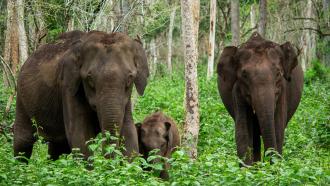![Cnemaspis bangara, one of the new species discovered. [Image Credits: Tejas Thakeray] Researchers find three new species of geckos lurking under granite rocks in the Mysore Plateau](/sites/researchmatters/files/styles/large_800w_scale/public/gecko1_23june.jpg?itok=dde6KOgN)
Cnemaspis bangara, one of the new species discovered. [Image Credits: Tejas Thakeray]
India is home to around 150 species of geckos, mostly found in the wet, mountainous habitats of the country. However, there are also several rock-dwelling species found in the drier areas of peninsular India, some of which are found in tall, rocky outcrops, suggesting that these boulders may serve as a refuge. In a recent study, herpetologists have discovered three new species of geckos belonging to the genus Cnemaspis. These geckos are thought to be endemic to the rocky granite boulders found in the Mysore plateau region of Karnataka.
The study involved researchers from the Thackeray Wildlife Foundation, Mumbai, National Centre for Biological Sciences and Indian Institute of Science from Bengaluru, and the Bombay Natural History Society, Mumbai. The researchers have also provided the first phylogenetic tree of Cnemaspis geckos which shows their evolution from early ancestors. They have estimated when these geckos diversified from their ancestors and moved from peninsular India into Sri Lanka and Southeast Asia. Their findings were published in the Journal of Zoological Systematics and Evolutionary Research.
The newly-discovered geckos belong to the genus Cnemaspis, which is the most diverse gecko genera having originated around 50 million years ago in the Western Ghats. Their diversity has been attributed to the fact that individual species occupy a very small range, which promotes the evolution of new species.
“The South Asian Cnemaspis include geckos that are diurnal, nocturnal, crepuscular and potentially cathemeral—active in the day and night depending on temperatures,” says Dr Ishan Agarwal, the lead author of the study.
Out of the 45 Cnemaspis species from India, ten are found in peninsular India outside the Western Ghats.

A male Cenemaspis graniticola [Image credits: Akshay Khandekar]
The three new species are described based on their structure and morphology and were found in the southern part of the Mysore plateau. The first species, Cnemaspis bangara draws its name from the Kannada word, bangara meaning gold, and was first found close to the famous gold mines of Kolar in Karnataka. Cenemaspis graniticola, from Horsley Hills in Andhra Pradesh, is called so as they are found on the granite rocks in this region. The third species, Cnemaspis yelagiriensis was found in Vellore, Tamil Nadu, and is named after the Yelagiri Hills.
All the three species were found on granite boulders of varying size and density, located at an altitude of over 1000m. They live in a habitat that consists of a mix of montane forests and open scrublands.
“The three species are medium-bodied, which distinguishes them from almost all other Cnemaspis outside the Western Ghats, which are small-bodied,” explains Dr Agarwal.
Researchers measure the size of geckos from their snout to vent. Small-bodied geckos are less than 4cm in length, medium-bodied ones ranging from 4-5cm, and large-bodied ones are greater than 5cm.
“The juveniles, adult males and adult females of C. bangara have bright yellow or orange tail-tips”, he adds.
Tracing the ancestry of the South Asian Cnemaspis geckos using genetic analysis, the researchers identified eight well-defined clades that evolved from the Western Ghats. A clade is a group of species that have originated from a single common ancestor. They found that most clades may have diverged during the Miocene-Pliocene period, which was about 7-25 million years ago. Their analysis also showed two independent divergences, one that occurred around 33 million years ago, and another about 10 million years ago, which resulted in the clades found in Sri Lanka and Southeast Asia today.

Cnemaspis yelagiriensis [Image Credits: Tejas Thackeray]
The Western Ghats are home to four clades of Cnemaspis geckos—goaensis, girii, heteropholis and kohlapurenses. Outside the Western Ghats, in peninsular India, are three distinct clades—mysoriances, gracilis and bangara. The bangara clade, to which the three new species belong, is also newly discovered. This clade consists of the rock-dwelling geckos and is said to have evolved about 25 million years ago, after splitting from its sister clade girii, which has its origins in the Northern Western Ghats.
Although the three new species were found in the plateau, it is thought that Cnemapsis species are unlikely to have adapted to such warm and dry climates. However, the researchers speculate that the microclimate of these high elevation rocky outcrops, which is considerably cooler than the ambient temperature, could be more favourable for these lizards. The boulders also provide a stable environment with minimal variations in the temperature as compared to low-lying areas. The researchers suggest that intensive sampling in these regions is likely to reveal many more new species.
With intense granite quarrying in these rocky habitats, Cnemaspis geckos and many other species found here, are quickly losing their homes.
“Granite quarrying is a major threat to the unique and endemic fauna and flora of the rocky outcrops and hills in peninsular India,” opines Dr Agarwal.
Further research into these rocky habitats and their microclimates, where many species may be thriving, could highlight their importance for conservation.
This article has been run past the researchers, whose work is covered, to ensure accuracy.






